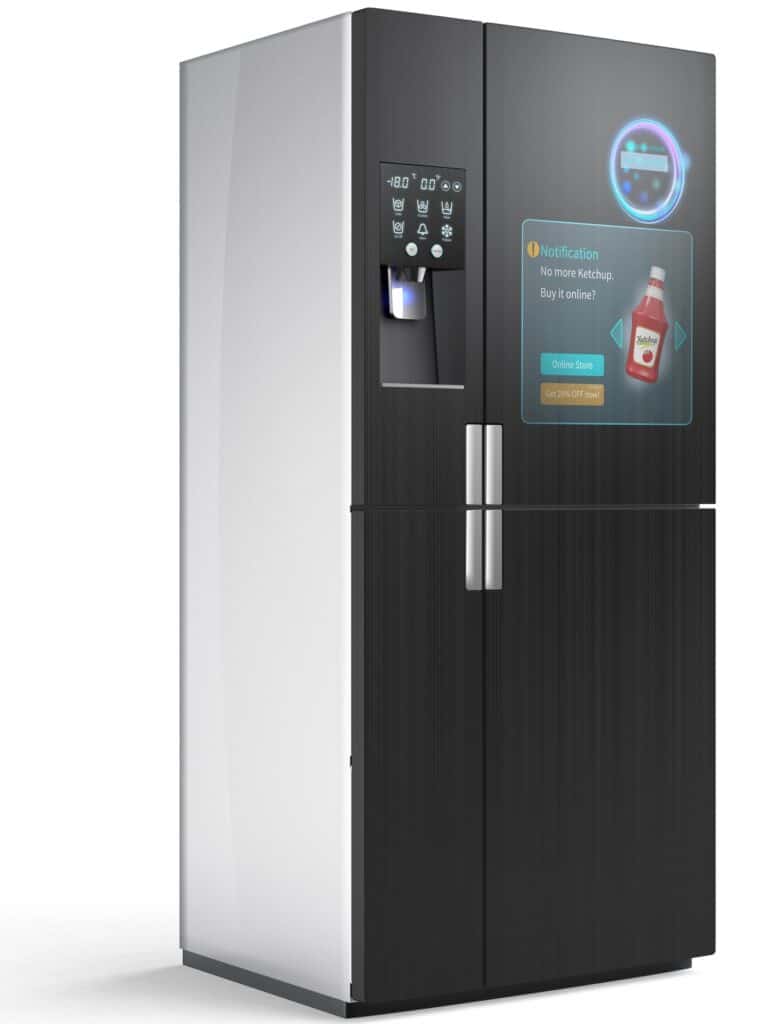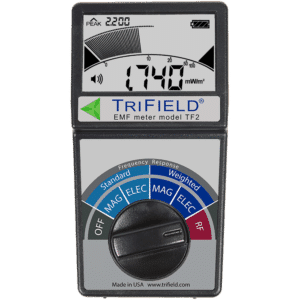Refrigerator EMF Radiation – Everything You Need To Know
*The information on EMF Academy is for educational purposes only and is not a substitute for professional medical advice. Please review our full Medical Disclaimer for more details. This post may contain affiliate links. Please see my disclosure to learn more.
Almost every modern home has a refrigerator, and for good reason.
Refrigerators provide a safe and efficient way to keep our meats, vegetables, fruit, and many other foods cold and fresh.
However, in order to accomplish this, refrigerators must produce EMF radiation, and I think you may be surprised at just how much they can produce.
For a very long time, refrigerators were fairly simple, and it was primarily the circuitry and electronics in the back that were producing EMF radiation.
However, your fridge is getting smarter.
You can now purchase fully connected refrigerators that not only monitor the kind and quantity of food inside but can also automatically order more food for you.
They often have digital displays on the front that produce similar amounts of radiation as a tablet.
These modern refrigerators can actually produce a large amount of EMF radiation.
First, let's talk a little bit about how your refrigerator works, and then we'll look at the details of much radiation it is likely producing, and how you can test this for yourself!
Why Do Refrigerators Emit EMF Radiation?
In order to have a good understanding of how exactly refrigerators produce EMF radiation, it will probably help to know a little bit about how they work.
Modern refrigerators use refrigerants (typically HFCs like tetrafluoroethane) that circulate through the internal piping of your fridge to keep your food cold.
The circulation of the chemicals is powered by an electric compressor, which is controlled by a thermostat. This way, you can set the temperature you want on your fridge, and the compressor will turn on and off as needed to maintain this temperature.
The primary source of EMF radiation from your refrigerator isn't the cooling chemicals, it's the electrical components, such as the compressor, the fans, the digital controls, or any other electronics.
These parts of your unit emit magnetic field radiation, a type of EMF radiation. This radiation emission will always be a bit higher when the compressor is running.
While most basic refrigerators produce low levels of radiation, newer models with digital screens, WiFi, Bluetooth, and internal sensors can also emit radiofrequency (RF) radiation, which adds to the total EMF exposure in your kitchen.
How Much Radiation Does A Refrigerator Produce
Modern refrigerators, luckily, produce a rather small amount of radiation.
As these units have become more advanced, they have also become more energy efficient, using less electricity and producing less radiation.
According to the Long Island Power Authority, which did a study of EMF radiation from home appliances, the average modern refrigerator exposes the body to:
- ~1.5 milligauss (mG) at a distance of 1 foot or less
- Less than 1.0 mG at a distance of 3 feet or more
This means that if you simply stand even a few feet further away, your radiation exposure is far less.
Most of this radiation that they are referring to is a form of low-frequency magnetic radiation that is generated by the compressor and other internal electronics.
What About Smart Refrigerators?

Where things change quite a bit is with WiFi-enabled smart refrigerators, because now it's both a fridge and essentially a Wi-Fi-enabled tablet.
Take the Samsung Family Hub Refrigerator, for example. These models include large touchscreen displays, built-in cameras, voice assistants, and are always connected to your WiFi.
That’s essentially like mounting a tablet or smartphone on the front of your fridge, and it’s always on.
These features introduce new forms of EMF, including:
- Radiofrequency (RF) radiation from the WiFi module
- Bluetooth radiation from syncing to phones or smart home hubs
- Extra magnetic fields from the display panel and electronics
So, while the refrigerator itself may only emit 1–1.5 mG of magnetic radiation, the smart components can dramatically increase total EMF exposure in your kitchen, especially if you spend time standing near the fridge.
| Feature | Standard Refrigerator | Smart Refrigerator |
|---|---|---|
| WiFi/Bluetooth Connectivity | ❌ No | ✅ Yes – always on |
| Touchscreen Display | ❌ No | ✅ Yes – like a built-in tablet |
| Typical Magnetic Field (at 1 ft) | ~1.5 mG | ~1.5 mG + additional electronics |
| RF Radiation | ❌ None | ✅ Yes – WiFi & Bluetooth |
| Energy Consumption | Lower | Typically higher |
| EMF Emissions Overall | Low | Medium to High |
| Best For EMF Sensitivity? | ✅ Yes | ❌ No |
How To Measure EMF Radiation From Your Refrigerator
The majority of the EMF radiation coming from your refrigerator will be magnetic, but it's best to measure all three types (magnetic, radio, and electric) to get a full understanding of the radiation.
The best way to measure this is to get a quality EMF meter. I always like to recommend the TriField TF2 (read my review) as it’s simple to use, lasts forever, is extremely accurate, and measures all three types of EMF radiation. If you’re wanting a low-cost EMF meter, I really like the Erickhill EMF Meter.
Once you have your EMF meter, start by taking a measurement in the middle of your kitchen, at least 5 or so feet away from the unit.
Try to determine if there is anything else that may be emitting a large amount of EMF radiation like your microwave.
Then, once you've found a baseline, slowly approach your refrigerator with the device set to “magnetic” to get a reading of the magnetic radiation being emitted.
You can then change the meter to measure other types of EMF radiation and determine if/how much it is emitting.
Check out the video below for a great example of measuring EMF radiation from a refrigerator. \
Now, in the video, it's a smart fridge, and therefore is also emitting radio frequency radiation.
Dangers Of Sleeping Near a Refrigerator
The vast majority of simple refrigerator units will only emit a small amount of radiation, and it is fairly localized, meaning the farther you are away, the less radiation you will be exposed to.
Unless the unit is on the opposite side of a wall that you are sleeping against, I would not worry about this very much.
There are far better ways to reduce radiation in the bedroom.
However, if you do sleep opposite a refrigerator unit and would like to reduce or eliminate the amount of EMF radiation you are exposed to while you sleep, the best thing you can do is get some EMF radiation shielding paint.
Take a look at my full review of Yshield paint for step-by-step instructions on how to do this.
How to Reduce EMF Radiation from Your Refrigerator
Even though they don't emit as much EMF radiation as some other household appliances, you may still want to reduce your exposure, especially if you're highly sensitive to EMF radiation.
Here are a few simple ways you can reduce your exposure from your fridge:
- Keep your distance: EMF strength drops off significantly with distance. Just standing 2–3 feet away while your fridge is running can dramatically reduce your exposure.
- Avoid leaning or standing next to it for long periods: Try not to rest or work right next to the fridge, especially when the compressor is running or if it’s a smart fridge with WiFi and Bluetooth always on.
- Disable smart features: If you have a smart refrigerator, disable the WiFi and Bluetooth in the settings. You can still use most of the core functions without needing to stay connected to your phone or the internet.
- Place shielding materials strategically: If your fridge backs up to a frequently used room (like a bedroom), consider using EMF shielding paint or shielding fabric on the shared wall to reduce transmission.
- Choose the right model: As covered above, simpler refrigerators with no display screens, cameras, or smart home connectivity will emit much less EMF radiation.
Low EMF Refrigerator Units
The best way to find low EMF refrigerator units is to take your EMF meter with you when you go shopping and measure the static amount of radiation being emitted.
This will allow you to measure each unit's magnetic field, electric field, and potentially radio frequency radiation.
If you don't want to do this (and I get it, it can be weird to take your Trifield to Home Depot), here are a few things that you should look for in a low EMF refrigerator:
- Skip Smart Features: I would advise avoiding models that advertise WiFi, Bluetooth, touchscreens, built-in cameras, or integration with your smart home. These features will constantly emit radiofrequency (RF) radiation.
- Go Simple/Analog: Try to choose a refrigerator with very simple and basic features and controls. The fewer electrical components, the lower the EMF output will be.
- Choose energy-efficient models: In general, more energy-efficient refrigerators use less power, which typically results in lower EMF emissions.
You're probably not going to see any refrigerators advertised as “low EMF” anytime soon, so you're best bet is to prioritize simplicity and energy efficiency, and if possible, to test the units yourself.
Final Thoughts On Refrigerator Radiation
Although most simple refrigerators produce a very small amount of radiation (<1-1.5 mG), this will likely not be the case for long.
As smart refrigerators become more common and cost-effective, you will see them in more homes. These units produce exponentially more radiation than their basic counterparts, as they essentially house a highly connected computer on the door panel.
All in all, if possible, choose the simpler, more energy-efficient, less smart refrigerator for a safer home!








